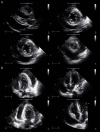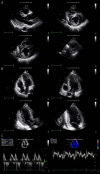A Case of Profound Hypothyroidism Presenting with Hypertensive Emergency and Large Amount of Pericardial Effusion
- PMID: 32565535
- PMCID: PMC7327733
- DOI: 10.12659/AJCR.923299
A Case of Profound Hypothyroidism Presenting with Hypertensive Emergency and Large Amount of Pericardial Effusion
Abstract
BACKGROUND Thyroid function is closely related to the cardiovascular system. Pericardial effusion is a well-known complication of hypothyroidism. It is common for massive pericardial effusion to progress to tamponed heart with hypotension, but not high blood pressure. CASE REPORT A 46-year-old woman presented to the hospital with dysarthria and left-side weakness of the upper limb which had started 30 minutes before her arrival at the hospital. The patient showed hypertensive emergency (213/124 mmHg) with intracerebral hemorrhage. Further evaluation for high blood pressure and transthoracic echocardiography demonstrated the presence of a large amount of pericardial effusion, and urgent pericardiocentesis was performed. The laboratory examination showed elevated thyroid-stimulating hormone and decreased free thyroxine level, leading to a diagnosis of primary hypothyroidism. The administration of current medications was maintained, including thyroid hormone replacement and anti-hypertensive drugs. CONCLUSIONS A rare case of profound hypothyroidism presenting with hypertensive crisis and massive pericardial effusion is described in this report.
Conflict of interest statement
None.
Figures




Similar articles
-
Massive pericardial effusion without cardiac tamponade due to subclinical hypothyroidism (Hashimoto's disease).Rural Remote Health. 2018 May;18(2):4384. doi: 10.22605/RRH4384. Epub 2018 May 20. Rural Remote Health. 2018. PMID: 29778090
-
Pericardial Effusion with Tamponade in Untreated Hypothyroidism.Am J Case Rep. 2023 Jan 19;24:e938520. doi: 10.12659/AJCR.938520. Am J Case Rep. 2023. PMID: 36654486 Free PMC article.
-
[Massive pericardial effusion as initial manifestation of hypothyroidism].Arq Bras Endocrinol Metabol. 2012 Aug;56(6):383-7. doi: 10.1590/s0004-27302012000600007. Arq Bras Endocrinol Metabol. 2012. PMID: 22990643 Portuguese.
-
[Cardiovascular effects of hypothyroidism].Ned Tijdschr Geneeskd. 2000 Apr 8;144(15):703-6. Ned Tijdschr Geneeskd. 2000. PMID: 10778718 Review. Dutch.
-
Pericardial Effusions: Causes, Diagnosis, and Management.Prog Cardiovasc Dis. 2017 Jan-Feb;59(4):380-388. doi: 10.1016/j.pcad.2016.12.009. Epub 2017 Jan 4. Prog Cardiovasc Dis. 2017. PMID: 28062268 Review.
Cited by
-
Hypothyroidism-Related Cardiac Tamponade.Cureus. 2021 Oct 8;13(10):e18611. doi: 10.7759/cureus.18611. eCollection 2021 Oct. Cureus. 2021. PMID: 34786222 Free PMC article. Review.
-
Pericardial Manifestations of Thyroid Diseases.Curr Cardiol Rep. 2022 Aug;24(8):893-904. doi: 10.1007/s11886-022-01711-7. Epub 2022 May 30. Curr Cardiol Rep. 2022. PMID: 35635677 Review.
-
Primary Hypothyroidism Unleashing Severe Pericardial Effusion: Lessons Learnt From an Atypical Presentation of a Common Endocrine Condition.Cureus. 2023 Oct 13;15(10):e46947. doi: 10.7759/cureus.46947. eCollection 2023 Oct. Cureus. 2023. PMID: 38021716 Free PMC article.
References
-
- Hardisty CA, Naik DR, Munro DS. Pericardial effusion in hypothyroidism. Clin Endocrinol (Oxf) 1980;13(4):349–54. - PubMed
-
- Kabadi UM, Kumar SP. Pericardial effusion in primary hypothyroidism. Am Heart J. 1990;120(6 Pt 1):1393–95. - PubMed
-
- Kerber RE, Sherman B. Echocardiographic evaluation of pericardial effusion in myxedema. Incidence and biochemical and clinical correlations. Circulation. 1975;52(5):823–27. - PubMed
-
- Yamanaka S, Kumon Y, Matsumura Y, et al. Link between pericardial effusion and attenuation of QRS voltage in patients with hypothyroidism. Cardiology. 2010;116(1):32–36. - PubMed
-
- Chahine J, Ala CK, Gentry JL, et al. Pericardial diseases in patients with hypothyroidism. Heart. 2019;105(13):1027–33. - PubMed
Publication types
MeSH terms
Substances
LinkOut - more resources
Full Text Sources
Medical

